and historical purposes, all rights reserved.
This page is copyright© by
This page may not be sold or distributed without
the expressed permission of the producer
I have no connection with any camera company
This camera manual library is for reference
and
historical purposes, all rights reserved.
This page is copyright© by
![]() , M.
Butkus, NJ.
, M.
Butkus, NJ.
This page may not be sold or distributed without
the expressed
permission of the producer
I have no connection with any camera company
On-line camera manual library
If you find this manual
useful,
how about a donation of $3 to:
M. Butkus, 29 Lake Ave.,
High Bridge, NJ 08829-1701
and send your
e-mail address
so I can thank you.
Most other places would charge
you $7.50 for a electronic copy
or $18.00 for a hard to read Xerox copy.
If you use Pay Pal, use the link below.
Use the above address for a
check, M.O. or cash.


Ricoh XR Speedlite 300P
PDF (differnet book)
- English only -
DESCRIPTION OF PARTS

|
1. Wide Angle Diffuser 2. Reflector 3. Light Sensor 4. Battery Compartment Cover 5. Lock Screw 6. Auto Check Sound Switch 7. Auto Lamp 8. TTL Mode Lamp
|
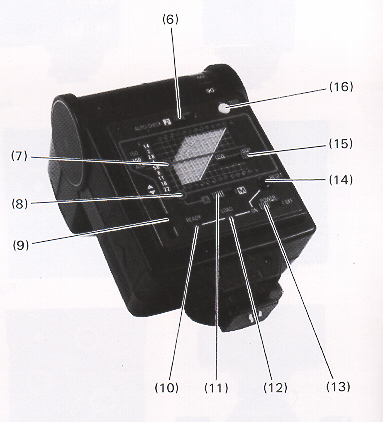 |
9. Film Speed Selector 10. Ready Lamp 11. A/M (Auto/Manual) Selector 12. Load-start Lamp 13. Power ON/OFF Switch 14. Reset Button 15. High/Low Selector 16. Test Button
|
INSERTING THE BATTERIES
 |
1. Slide the battery compartment cover in the direction of arrow to open.
(Fig. 1 )
2. Insert four penlight (AA size) batteries in accordance with the polarity diagram shown inside the battery compartment (Fig. 2) 3. Close the battery compartment cover by sliding it. |
* Generally, the performance of batteries drops in cold conditions. When the
flash is used at a temperature lower than 0 C (32°F), warm the batteries and
insert them just before shooting.
* When the flash unit is not used for a long period of time, unload
the batteries.
TESTING THE FLASH UNIT
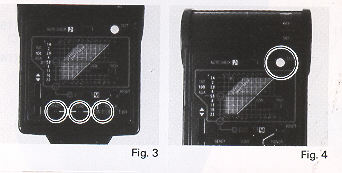 |
1. Turn ON the power with the ON/OFF
switch. (Fig. 3)
2. The load-start lamp (LOAD) lights up immediately, followed by the ready lamp (READY) about 9 sec. later. (Fig. 3) 3. Push the test button and make sure that the flash unit flashes. (Fig.4) |
ATTACHING THE FLASH UNIT TO THE CAMERA
 |
1. Loosen the lock screw and insert the flash unit fully into the hot shoe
of the camera. (Fig. 5)
2. Turn the lock screw in the * Do not use the flash with other makes of cameras that have a special signal pin(s), as this will result in incorrect exposure or may even damage the camera circuitry. |
WHEN USED WITH THE XR-P
When the flash unit is used with the XR-P, the shutter speed and f-stop number
are automatically set when the camera is set to program AE photography.
Flash photography is by a direct metering system and light is measured off the
him plane to control the flash duration.
(PROGRAM AE FLASH PHOTOGRAPHY)
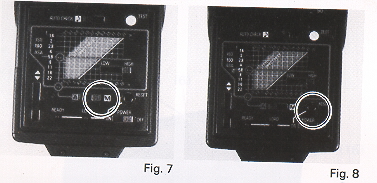
1. Slide the film speed selector to set the speed of film you are using in the
film speed window. (Fig. 6)
2. Set the A/M (AUTO/MANUAL) selector to "A" (AUTO). (Fig. 6)
3. Set the HIGH/LOW selector to "HIGH". (Fig. 6)
4. Set the auto check sound switch to "musical note". (Fig. 6)
5. Turn ON the power ON/OFF switch. The load-start lamp will light up and at the
same time the TTL mode lamp will light up to indicate that the flash is set to
TTL direct auto flash. (Fig. 6)
6. Set the camera to the program AE photography.
7. Select the program according to the picture-taking conditions, referring to
the following table.
(ASA/ISO 100 film)
| Program | Automatic- f-stop setting | Automatic flash range | Subject/situations |
| PD | F11 | 0.5-2.7m 1.6~-8.9' |
When you want maximum depth of focus. |
| P | F5.6 | 0.5 - 5.3m 1.6' - 17.4' |
General snap shots |
| PA | F2.8 | 1.0m - 11m 3.3' - 36.1' |
* A distant subject * Continuous picture taking because of shorter recycling time. |
* You can check the automatic flash range in combination of
f-stop and film speed by flash's built-in "FLOATING" scale.
8. When the flash is fully charged, the ready lamp lights up, and the flash
ready light in the finder of the camera lights up.
9. When flash shot is made with correct exposure, the correct auto flash
indicator in the finder of the camera blinks and electronic sound can be heard
from the flash unit.
10. If the correct auto flash indicator does not blink, and no electronic sound
is heard, exposure is not correct. In this case, change taking conditions; (1 )
set program selector to PA or (2) select wider lens opening manually or (3)
bring the camera closer to the subject.
* Electronic sound can be eliminated with the auto check sound switch.
(APERTURE-PRIORITY AE FLASH PHOTOGRAPHY)
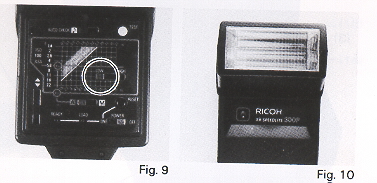
With the XR-P, the TTL direct auto flash is available with all f-stop numbers
for total creative depth of field control. Use wider lens opening (F2.0, F2.8)
to take a distant subject or to reduce flash charge time. Use smaller lens
opening (F11, F16) to increase depth of field.
1. Set the desired f-stop number.
2. Set the shutter dial to "A".
Automatic Flash Range at Each F-Stop Number
| F-Stop | Automatic flash range |
| F1.4
2 2.8 |
2 (6.6')-21 m (69') 1.4 (4.6') -15 (49') 1 (3.3')-11 (36') 0.7 (2.3') ' 7.5 (24.6') 0.5 (1.6')- 5.3 (17.4') 0.5 ( 1 .6') - 3.8 ( 12.5') 0.5 (1.6')- 2.7 ( 8.9') 0.5 (1.6')- 1.9 ( 6.2') 0.5 (1.6')- 1.4 ( 4.6') |
(ISO/ASA 100 film) *
* The shutter speed can be changed to manual shutter speed (1/125 sec. or slower). If faster speed than 1/125 sec. is selected, the shutter speed is automatically set to 1/125 sec. at the moment the flash is fully charged.
USE THE 300P WITH CAMERAS OTHER THAN THE XR-P
The 300P can be used with cameras other than XR-P as an auto flash, however,
auto flash control is done by the sensor on flash unit and direct off the film
metering is not available.
* Set the F-stop referring to the following table.
* Set the shutter speed to a synchronizing speed of your camera.
(Ricoh XR-2S, KR-10, KR-10 Super, XR-7, XR-6, XR-S can be used with shutter dial
set to "A''.)
* Whether flash shot is made with correct exposure or not can be
checked by electronic sound.
F-stop Setting According to Film
Speed
| Film speed (ISO/ASA) | F-stop |
| 25 50 100 200 400 1000 |
2.8 |
MANUAL FLASH PHOTOGRAPHY
1. Set the A/M selector to "M". (Fig.7)
2. Set the shutter speed to 1/125 sec. or lower.
3. Focus on the subject, and read off the distance from the camera to subject.
4. Calculate the correct f-stop using the following formula.
Guide Number [30 (98, feet) with ISO 100 film]
Distance
For example, when the distance is 7.5m (24.6 ft) and ISO/ASA 100 is used, the
correct f-stop is 4.
* Guide number changes according to the speed of film.
| Film speed | Guide Number |
| 25 50 100 200 400 1000 |
15 (49) |
FLASH IN DAYLIGHT
The subject is affected by strong background light when taking
pictures in back light. Dark pictures (face etc.) may be produced. Properly lit
pictures can be obtained by using flash even in daylight. This is known as
"fill-flash". When the 300P is used on the XR-P, pro daylight flash can be
easily accomplished even by novice photographers.
1. Set the A/M selector to "A".
2. Set the camera in the program AE mode.
3. When fully charged, the flash ready indicator lights in the viewfinder of
camera and shutter speed is set automatically to 1/125 sec. Then, the f-stop
number is displayed in the viewfinder. Now you can shoot if you don't see an
overexposure ![]() mark.
mark.
* The shutter speed dial set to "A" can be changed to manual shutter speeds
(1/125 sec. or lower). Use longer manual speed to give correct exposure to the
background in a room or other dark condition. When you've selected, for example,
the shutter speed of 1/30 sec. and if the subject is too bright at this speed,
any shutter speed up to 1/125 sec. will be selected automatically according to
the brightness of the subject.
AUTO SHUT OFF
The 300P is designed to shut off the power supply automatically to
save the battery energy even the ON/OFF switch is ON.
With XR-P Power consumption stops approx. 5 minutes after the last flash.
With cameras other Power consumption stops than XR-P approx. 4 minutes after the
last flash.
The charging can be started again by pressing the reset button. (Fig. 8)
HIGH/LOW SELECTOR
When High/Low selector is set to "LOW", the guide number becomes 7
(23, ft) (ISO/ASA 100 film). This is ideally suited for continuous flash
photography with winder or motor because of shorter recycling time. (Fig. 9)
* The flash unit can be used as auto flash or manual flash with LOW light
setting.
* With the XR-P, we suggest ''PA" program or wider lens opening (F2.0, F2.8)
should be selected.
Auto Flash Range (LOW light)
| F-Stop | Auto flash range (m) |
| F1.4 F2 F2.8 F4 F5.6 F8 F11 |
2 (6.6')-5 (16.4') |
(ISO/ASA 100 film)
BOUNCE PHOTOGRAPHY
You can tilt the flash head in vertical direction by 90°. Use bounce flash
when you wish to have a softer effect and to eliminate harsh shadow on your
subject. When taking flash pictures indoors, bounce the light off the white or
reflective colored walls, ceiling. (Fig. 10)
* It is recommended to set XR-P to "PA'' program or select wider lens opening
(F2.0, F2.8) for bounce flash as the amount of light reaches the subject is
reduced.
* Whether flash shot is made with correct exposure can be confirmed by
electronic sound.
WIDE ANGLE DIFFUSER
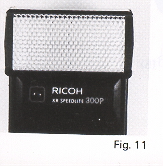
The 300P can be used with wide angle lens up to 35mm lens. When a
wider angle of lens than 35 mm is used, use the wide angle diffuser. Then a wide
angle lens up to 24 mm can be used. (Fig.11)
* When the wide angle diffuser is mounted, the guide number becomes 21 (69, ft)
(ISO/ASA 100 film). And the distance of auto flash shot is shortened by
approx.40% compared with the normal use.
* Exposure setting is the same as when using without wide angle diffuser.
PROPER CARE OF YOUR FLASH
* Even if you do not use the flash for an extended period of time,
it should be tested from time to time in order to properly maintain the
condenser.
* A high voltage is generated in the circuitry. It is very dangerous to take it
apart or to touch the inside of the flash unit. It should be taken to a camera
dealer or a recognized Ricoh service station for all repairs.
* Avoid exposing the flash unit to dust, humidity, rain, seawater, etc.
* Do not leave it in hot or humid condition such as direct sunlight, as this
will cause malfunction of the flash unit.
* Clean the body of the flash unit with a dry soft cloth. Never use solvent such
as thinner, benzene, etc.
SPECIFICATIONS
Type: Thyristorized TTL direct automatic flash unit
Guide Number: HIGH 30 (98, ft) (ISO/ASA 100 m.) LOW 7 (23, ft) (ISO/ASA 100
m.) with wide angle diffuser HIGH 21 (69, ft) (ISO/ASA 100 m.) LOW 5 (16, ft)
(ISO/ASA 100 m.)
Flash Duration: 1 /1000 1/4000 sec.
Recycling Time: 9 sec. (Shorter depending on camera setting and subject
distance)
Coverage Angle: 45° on vertical and 60° on horizontal, with wide angle
diffuser 60° on vertical and 78° on horizontal
Bouncing: 0° - 90° (Click-stop at each 15°)
Auto Shut Off: 4 minutes
Number of Flashes: About 150 flashes with Alkaline batteries
About 75 flashes with Nickel Cadmium batteries
About 50 flashes with Manganese batteries
Power Source: 4 penlight (AA size) batteries 1.5V
Other features:
One touch resetting capability
Auto check sound
Switchable High/Low
Floating distance scale.
Dimensions: 74(W)x115(H)x89(D)mm(2.9"x4.5"x3.5")
Weight: 250g (without batteries) (8.8 oz)